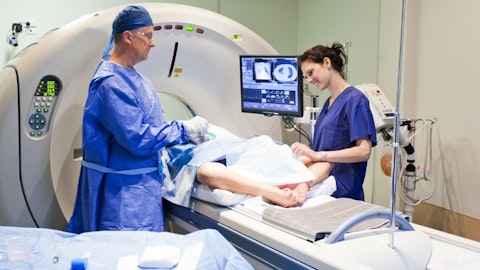Predictive Oncology Inc. (NASDAQ:POAI) Q4 2023 Earnings Call Transcript April 1, 2024
Predictive Oncology Inc. isn’t one of the 30 most popular stocks among hedge funds at the end of the third quarter (see the details here).
Operator: Greetings and welcome to the Predictive Oncology Fourth Quarter 2023 Earnings Call. At this time all participants are in a listen-only mode. A brief question-and-answer session will follow the formal presentation. [Operator Instructions]. As a reminder this conference is being recorded. It is now my pleasure to introduce your host, Glenn Garmont, LifeSci Partners. Thank you Glenn, you may begin.
Glenn Garmont: Welcome, and thank you, everyone, for dialing into the Predictive Oncology full year 2023 financial results call. First, you’ll hear from our Chief Executive Officer and Chairman of the Board, Raymond Vennare; then our Chief Financial Officer, Josh Blacher, will review our financials. Certain matters discussed on this call contain forward-looking statements. These forward-looking statements reflect our current expectations and projections about future events and are subject to substantial risks, uncertainties, and assumptions about our operations and the investments we make. All statements other than statements of historical facts included in the call regarding our strategy, future operations, future financial position, future revenue and financial performance, projected costs, prospects, plans, and objectives of management are forward-looking statements.

The words anticipate, believe, estimate, expect, intend, may, plan, would, target, and similar expressions are intended to identify forward-looking statements, although not all forward-looking statements contain these identifying words. Our actual future performance may materially differ from that contemplated by the forward-looking statements as a result of a variety of factors, including, among other things, factors discussed under the heading Risk Factors in our filings with the SEC. Except as expressly required by law, the company disclaims any intent or obligation to update these forward-looking statements. And now I would like to turn the call over to Raymond Vennare, Chief Executive Officer. Raymond?
Raymond F. Vennare: Thank you, Glenn. And good morning, everyone. It has now been slightly more than 12 months since we essentially restructured, repositioned, and implemented our new strategic vision for predictive oncology. And I have to say that I’m very pleased with the progress that we’ve made in a relatively short period of time. We have not only identified previously unutilized assets within the company, but we have further bolstered one of our most significant and valuable assets, our intellectual property and trade secrets. Sometimes progress is invisible. Trying on this unique set of integrated assets and capabilities, we have now begun to articulate what we believe is a compelling offering for accelerating oncologic drug discovery and development on a global scale.
2023 was a difficult but important year for us. It was transitional and necessary. Rebuilding is never easy. It was also a year of learning and responding to that knowledge. It has enabled us to incorporate valuable commercial lessons from our first year in the market to further refine our business development initiatives and set the stage for accelerating growth moving forward. As reminder, and particularly for those who may be new to our story, Predictive Oncology is unique in the evolving artificial intelligence in drug discovery market. We are the only company to our knowledge that is able to bring together cutting edge artificial intelligence and active learning technology with a proprietary biobank of more than 150,000 tumor samples, more than 25 years of longitudinal patient specific drug response data, a CLIA certified wet lab and more than 200,000 pathology slides, which are currently being digitized and incorporated into our PEDAL platform.
See also 25 Best Cities in US with Great Weather for Retirees and 12 Best Places to Retire in New Hampshire.
Q&A Session
Follow Predictive Oncology Inc. (NASDAQ:POAI)
Follow Predictive Oncology Inc. (NASDAQ:POAI)
We can add to that reservoir of proprietary assets more than 40,000 formalin fixed paraffin embedded blocks of human tissue, and an expanding portfolio of intellectual property. This platform, which is more than just an artificial intelligence platform, but its scientific methodology generates efficient, highly accurate predictions of how tumors respond to drugs, and supports those in silico predictions with clear validated in vitro experimentation. Our biobank allows us to introduce patients and tumor heterogeneity into the earliest phases of drug development, which enables our partners to gain critical insight into the prioritization and future development of potential drugs that have greater or lesser degrees of clinical success well before human clinical trials are initiated.
Having technically, scientifically, and commercially validated PEDAL platform, we have clearly demonstrated that we are able to predict if a tumor will respond to a given drug with 92% accuracy. The implication for drug developers is that they can mitigate the risk of failure and expedite the probability of success in ways that have never been seen before. It has been well documented that drug development is inherently expensive and risky, particularly in the area of oncology. Over the past 20 years, in fact, there have been approximately 1500 drugs selected for clinical trials, only 115 of which were ultimately approved for clinical use. In other words, less than 8% of all cancer drugs that enter Phase 1 trials are actually approved by the FDA.
By harnessing the power of our PEDAL platform, drug developers are able to save many millions of dollars and thousands of man hours, pursuing the development of drug candidates that we predict are most likely to succeed in the clinic, while avoiding the risk of the dancing candidates, which we may have predicted, might fail in later stages of clinical trials. With PEDAL, we are also able to generate proprietary data that can aid our drug development partners in training novel AI, broad tumor response models. While others in our industry have certainly attempted to replicate what we have already developed, and currently own, they simply cannot duplicate the comprehensive historical archive of tumor samples, drug response data, and domain expertise that we possess.
This speaks volumes about the importance of our unique ability to integrate data from multiple sources into a single solution that can successfully introduce tumor heterogeneity into the early drug discovery. Moreover, we believe our biobank and large repository of drug response data gives us an enduring competitive advantage that will take years if not decades to reproduce. Although we don’t discuss this as much as we could, the fundamental significance of owning and controlling the entire continuum of biological samples, historical drug response data, computational capacity, anthology reference sets and wet lab experimentation means that we are in control of our own destiny with respect to the use of these assets. Ultimately, if not inevitably, we will not only be in a position to identify drug candidates ourselves, but to license those candidates directly to Big Pharma.
I would now like to provide an update on some of our more notable engagements from 2023 beginning with cancer research horizons. Recall that we have been working with CRH, the world’s largest private funder of cancer research to evaluate three of their preclinical glutaminase inhibitor drug compounds to determine which cancer types and patient populations are most likely to respond to treatment with those compounds. In only a matter of a few weeks of actual lab time, we were able to deliver the results of this first campaign, which was able to identify subpopulations of patients that were more responsive to their compounds across four different tumor types, colon, liver, lung, and ovary. Armed with this information, CRH is now in a position to prioritize the development of the strongest candidates on the ideal tumor types and in the process gave significant time and resources by pursuing only those targets that are most likely to succeed in the clinic.
The next step here might be to use a sampling of the subpopulations of interest, presumably responders in one or two of the tumor types of interest to perform more extensive molecular sequencing, including DNA, or whole exome and or RNA or whole transcriptome. This would provide much more information for the purpose of better defining responsive patient tumor samples. From our perspective, this engagement with CRH provides crucial third party validation of our PEDAL technology and serves as an important reference point as we engage with other leading cancer drug discovery and drug development companies. Turning now to UPMC Magee-Women’s Hospital, we announced last quarter that we successfully completed a multi-year retrospective study, build multi-omic machine learning models that could predict overall short and long term survival in ovarian cancer.
Ovarian cancer treatment represents an unmet need in oncology, with epithelial COVID [ph] ovarian cancer being the deadliest of all kinds of cologic malignancies. While these cancers are sensitive to frontline chemotherapy in approximately 75% of the cases, these women will ultimately experience disease relapse in an equal percentage which is incurable. Outside of primary chemotherapy, there is no universal treatment decision path to determine the agent, sequence, and timing of the standard of care chemotherapeutic agents. The Magee Study included data from 235 ovarian cancer patients, and was designed to identify key features that drive overall survival endpoints. We are very pleased to say that we were able to deliver strong predictive models with high levels of accuracy and our machine learning capabilities demonstrated the ability to identify prognostic subgroups within an ovarian cancer patient population.
We continue to engage with Magee on additional methods of incorporating these models into clinical practice. One potential application would be the development of an AI driven decision support tool, leveraging the features that we identified as having prognostic importance for the model to tailor therapies for individual patients and positively affect overall survival. Another such application would be to drive more efficient and effective clinical trial designs. While these discussions are ongoing, we are in parallel, utilizing this information for purposes other than clinical utility. The possibility certainly does exist to reevaluate this data to develop biomarker leads, digital pathology applications, and new predictive models for other cancer types, as well as models for drug rescue, drug repurposing, and drug combinations.




